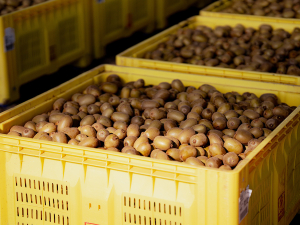Zespri Forecasts Record Returns for 2025/26 Kiwifruit Season
According to Zespri's November forecast for the 2025/26 season, returns are likely to be up for all fruit groups compared to the last forecast in August.
 Zespri’s Northern Hemisphere production plays a central role in supporting its objective of maintaining 12-month supply.
Zespri’s Northern Hemisphere production plays a central role in supporting its objective of maintaining 12-month supply.
Zespri’s counter-seasonal Zespri Global Supply (ZGS) programme is underway with approximately 33 million trays, or 118,800 tonnes, expected this year from orchards throughout France, Italy, Greece, Korea, and Japan.
That includes 26 million trays of Zespri SunGold Kiwifruit (or 93,600 tonnes), a 30% increase on last season, alongside 7 million trays of procured Zespri Green Kiwifruit from Greece and Italy (25,200 tonnes).
Nick Kirton, Zespri's executive officer - northern hemisphere supply, says the increase in SunGold volumes reflects mostly favourable growing conditions, with Italy contributing a 35% increase in Zespri SunGold and Zespri Organic SunGold volumes compared to last season.
“Following the completion of sales of New Zealand-grown SunGold Kiwifruit in Europe, our ZGS SunGold sales programme has now been underway for the past few weeks," says Kirton.
"We’ll also be transitioning to ZGS-grown SunGold Kiwifruit in our Asia markets and in the US in December, with Zespri Green sales getting underway as soon as we’ve wrapped our New Zealand Green programme, with Europe now underway,." he adds.
Zespri’s Northern Hemisphere production plays a central role in supporting its objective of maintaining 12-month supply to customers and consumers in global markets to support its position as the category leader in kiwifruit, strengthening New Zealand and offshore grower returns.
Kirton says Zespri is looking forward to providing more high-quality, great tasting kiwifruit from the Northern Hemisphere in the coming years.
Work has been underway since January to roll out the additional 420 hectares of Zespri SunGold Kiwifruit for Zespri’s Northern Hemisphere growing regions following the successful New Zealand Producer Vote at the end of 2024.
This includes 300 hectares allocated to Italy, 70 to Greece, and 40 to France with the remaining area to be developed in South Korea.
This expansion marks the first commercial production of SunGold Kiwifruit out of Greece. Zespri is also set to be able to provide customers and consumers in Europe with its red-fleshed Zespri Red variety, with the commercialisation of 170 hectares of red approved in Italy over the next two years.
“The expansion of our Northern Hemisphere growing operations has sent a clear signal of our confidence in the long-term demand outlook for Zespri Kiwifruit and enables us to continue partnering with the best local growers.
“Each season, we work closely with our supply chain partners to improve productivity while maintaining the highest quality standards that define our brand, and we’re looking forward to a strong start to the Northern Hemisphere sales season,” Kirton concludes.
Federated Farmers says almost 2000 farmers have signed a petition launched this month to urge the Government to step in and provide certainty while the badly broken resource consent system is fixed.
Zespri’s counter-seasonal Zespri Global Supply (ZGS) programme is underway with approximately 33 million trays, or 118,800 tonnes, expected this year from orchards throughout France, Italy, Greece, Korea, and Japan.
Animal owners can help protect life-saving antibiotics from resistant bacteria by keeping their animals healthy, says the New Zealand Veterinary Association.
According to analysis by the Meat Industry Association (MIA), New Zealand red meat exports reached $827 million in October, a 27% increase on the same period last year.
The black and white coat of Holstein- Friesian cows is globally recognised as a symbol of dairy farming and a defining trait of domestic cattle. But until recently, scientists didn’t know which genes were responsible for the Holstein’s spots.
According to the New Zealand Dairy Statistics 2024/25 report, New Zealand dairy farmers are achieving more with fewer cows.